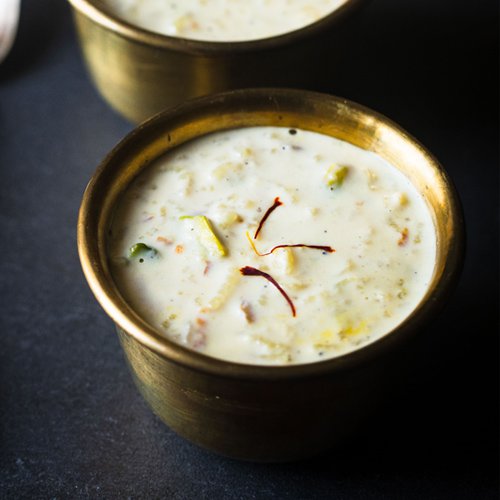We all love a bowl of delicious Kheer. This delicacy is cooked especially during festivals. This sweet is known by many names across the country. It is known as meetha bhaat, payasam, payasa, and phirni. Traditionally this dish is cooked by boiling milk sugar or jaggery along with one of the following ingredients, rice, some pulses, broken wheat, sabudana and vermicelli. It is then flavoured with cardamom, nuts , coconut, saffron. Kheer or paysam both have originated fro Sanskrit root kṣeer / kshira which means Milk.
Kheer is prepared in festivals, temples, and all special occasions. There is one more popular version of North Indian kheer, prepared during festivals and havan in Varanasi by using only milk, rice, ghee, sugar, cardamom, dried fruit, and kesar (saffron milk). It is an essential dish in many Hindu feasts and celebrations. While the dish is most often made with rice, it can also be made with other ingredients, such as vermicelli (semiya in South India, seviyan, seviyaan, sayviah, or other spellings) or tapioca (locally known as sabudana).
In Orissa this delicacy was known to be made from last 2000 years, in the Puri temple for pleasure of lord jagannatha. In the vedic period we find a mention of Krsara, a dish made with rice, milk an sesame. In the early Jaina and bhuddist works we find mention of Rice being sweetened and then eaten. Krsara, milk rice are were also relished during the Ramayan era and are widely mentioned in the epic. In the epic age rice and parched rice were often sweetened with Honey. The popularity of Kheer grew right until the mogul era, where they introduced Firni a variant of kheer.
In the south India Payasam is made with jaggery and coconut milk being main ingredient. In a South Indian meal, payasam or payasa, is served first at any formal or auspicious occasion. Payasam is also served after rasam rice, while rice with buttermilk forms the last item of the meal. Payasam also forms an integral part of the Kerala feast (sadya), where it is served and relished from the flat banana leaf instead of cups.
The Payasam of Kerala’s Alambuza is a must try delicacy. There was a king in Kerala, Chembakasserry King Devanarayanan, (Pooradam Thirunal Devanarayanan Thampuran) was a ruling Namboothiri King. Who was a champion in chess, and was undefeated. Because of his huge ego , and desire to be defeated. Lord Krishna disguised as a young boy and challenged the king for a chess match and defeated him twice. The king wanted to gift the boy something in return. The boy then asked the king to give him grains of rice “starting from the first square, one grain of rice would be placed, and would be kept on doubling for every next square till the 64th square, of the chess board. It would be 1 in the first, 2 in the second, 4 in the third, 8 in the fourth and so on. The king immediately ordered his men to fulfill the boys wish, the king then exhausted all this granary and still could not fulfill the boys wish. The boy then came to his real form and king asked for forgiveness form lord Krishna, Krishna then told the king that you can repay in installments. To this day the temple is serving rice payasam as part of repayment of the debt that the king owed.


